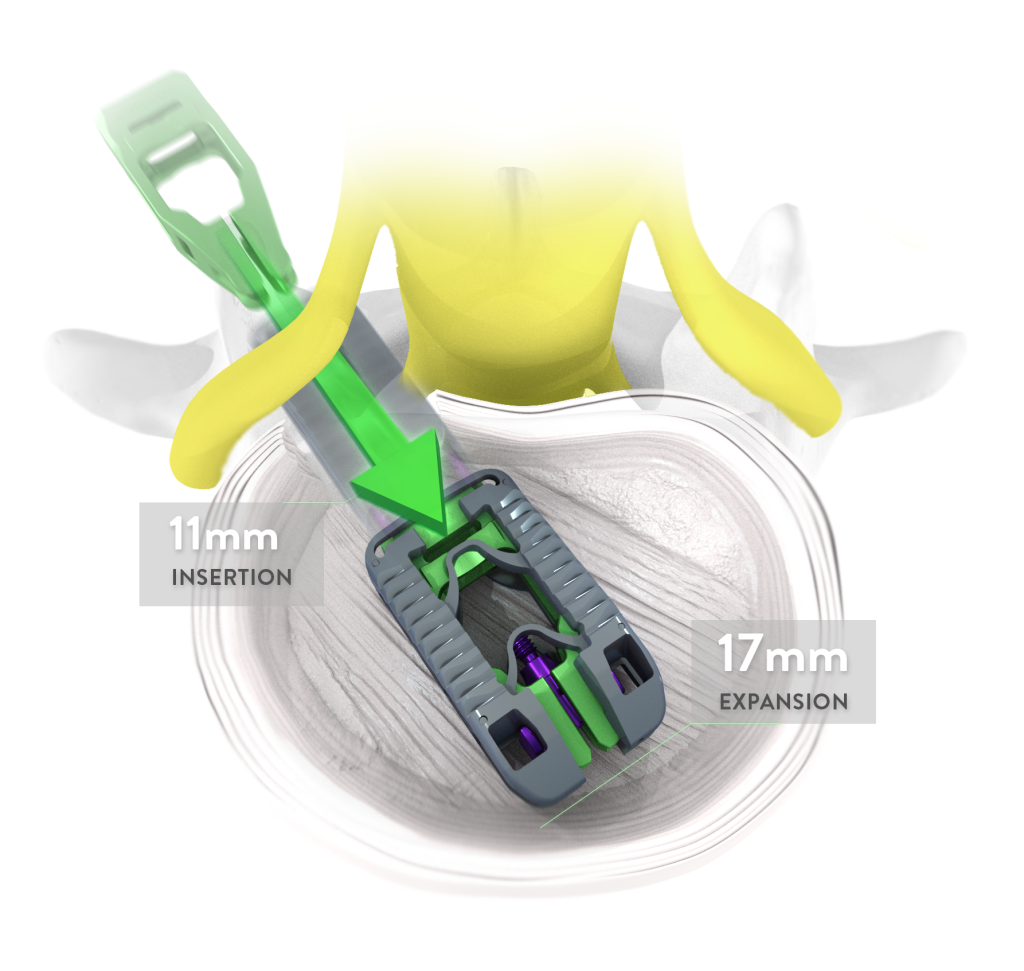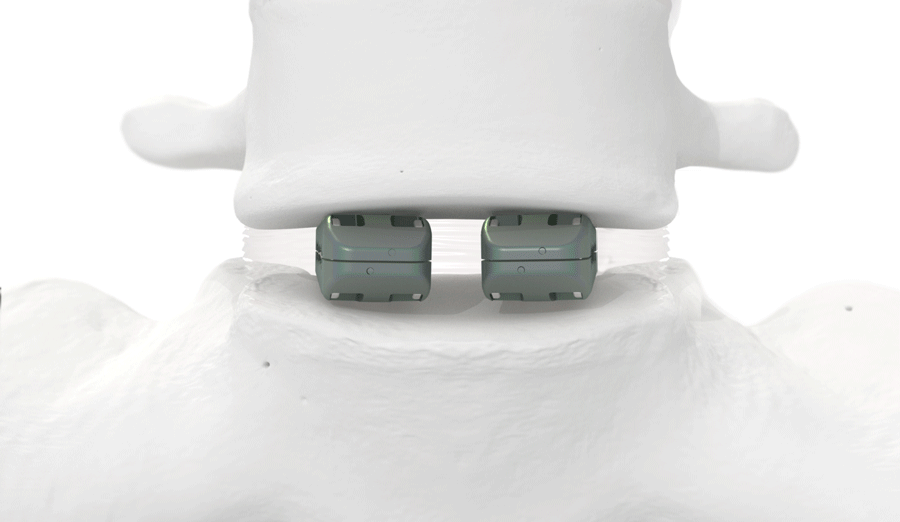
INTERBODY FUSION SYSTEM
ENDPLATE-CONFORMING1 EXPANDABLE INTERBODY
The FlareHawk® Interbody Fusion System utilizes Adaptive Geometry™ to expand simultaneously in width, height, and lordosis after traversing the neural corridor with a small profile. Once expanded, the conformable implant is designed to reduce subsidence, restore foraminal height, and reestablish sagittal balance from a posterior approach.

Expansive Footprint,
Minimal Retraction
A 17mm-wide implant can be placed with the retraction required for an 11mm implant. That’s a 55% footprint increase with no additional retraction.
FlareHawk provides multiple insertion profile and footprint options to help accommodate patient- and level-specific neural corridors.


Conformable Footprint
The multimaterial construct of the cage conforms to each patient’s endplate topography when expanded.
Coronal Conformity (TiHawk11)
Maximum Graft Delivery

Titanium
SURFACE TECHNOLOGY

PEEK
Stiffness properties comparable to bone, inertness and biocompatibility.2,3
Combination
The combination of PEEK + titanium may permit a modulus more similar to bone and potentially overcome concerns regarding the inertness of PEEK and limited fixation with bone.4,5
Titanium
Roughened titanium has properties that may allow for enhanced bone fixation against surfaces.6
Uninhibited Radiographic Views
The 0.5-micron-thick layer of titanium enables the visualization of the implant components along with the ability to assess fusion with an x-ray.
Lateral Fluoroscopy (TiHawk11)


For Every Approach
TLIF
PLIF
ENDOSCOPIC ASSISTED
KAMBIN'S APPROACH
CLINICAL
OUTCOMES
RETROSPECTIVE
ANALYSIS
Bidirectional Expandable Technology for Transforaminal or Posterior Lumbar Interbody Fusion: A Retrospective Analysis of Safety and Performance7
129
Patients Over Three Study Sites
97.4%
Levels Achieving Fusion Based on Bridwell-Lenke Grading
0
Reported Device-Related Adverse Events
0% Nerve Injuries Reported
0% Subsidence*
0% Endplate Fracture Reported
1 Case Device Migration**
100% Utilized Autograft Or Allograft
(No BMP Used)
88% Minimally Invasive Approach
58%
Patients with Clinically Significant Improvements in
ODI
76%
Patients with Clinically Significant Improvements in
VAS BACK PAIN
71%
Patients with Clinically Significant Improvements in
VAS LEG PAIN
*Cage subsidence defined as an overlap between the vertebral endplates and the device exceeding 25% of the device height.
**Device migration was defined as displacement of the device relative to the position within intra-operative or immediate post-operative images.


Click here to access MRI safety information for the FlareHawk Interbody Fusion System.
INDICATIONS FOR USE/INTENDED USE
The FlareHawk Interbody Fusion System is indicated for spinal intervertebral body fusion with autogenous bone graft and/or allogeneic bone graft composed of cancellous and/or corticocancellous bone in skeletally mature individuals with degenerative disc disease (DDD) at one or two contiguous levels from L2 to S1, following discectomy. DDD is defined as discogenic back pain with degeneration of the disc confirmed by history and radiographic studies. These patients should have at least six (6) months of non-operative treatment. Additionally, these patients may have up to Grade 1 spondylolisthesis or retrolisthesis at the involved level(s). FlareHawk system spacers are intended to be used with supplemental fixation instrumentation, which has been cleared for use in the lumbar spine.
Refer to the FlareHawk Interbody Fusion System Instructions for Use for full prescribing information.
1. Cheng BC, Swink I, Yusufbekov R, Birgelen Michele, Ferrara L, Coric D. Current Concepts of Contemporary Expandable Lumbar Interbody Fusion Cage Designs, Part 2: Feasibility Assessment of an Endplate Conforming Bidirectional Expandable Interbody Cage. International Journal of Spine Surgery. https://www.ijssurgery.com/content/14/s3/S68. Published December 1, 2020.
2. Warburton, A., Girdler, S. J., Mikhail, C. M., Ahn, A., & Cho, S. K. (2020). Biomaterials in Spinal Implants: A Review. Neurospine, 17(1), 101–110. https://doi.org/10.14245/ns.1938296.148.
3. Ong, Y. (2015). New biomaterials for orthopedic implants. Orthopedic Research and Reviews, 7, 107–129. https://doi.org/10.2147/ORR.S63437.
4. Enders JJ, Coughlin D, Mroz TE, Vira S. Surface Technologies in Spinal Fusion. Neurosurg Clin N Am. 2020 Jan;31(1):57-64. doi: 10.1016/j.nec.2019.08.007. Epub 2019 Oct 24. PMID: 31739930.
5. Kurtz, S. M., & Devine, J. N. (2007). PEEK biomaterials in trauma, orthopedic, and spinal implants. Biomaterials, 28(32), 4845–4869.
6. Ratner, B. D. (2004). Biomaterials science: An introduction to materials in medicine. Amsterdam: Elsevier Academic Press.
7. Domagoj Coric, Raphael R. Roybal, Mark Grubb, Vincent Rossi, Alex K. Yu, Isaac R. Swink, Jason Long, Boyle C. Cheng and Jason A. Inzana in International Journal of Spine Surgery October 2020, 7123; DOI: https://doi.org/10.14444/7123


